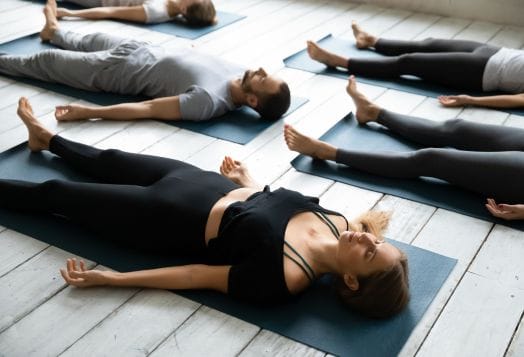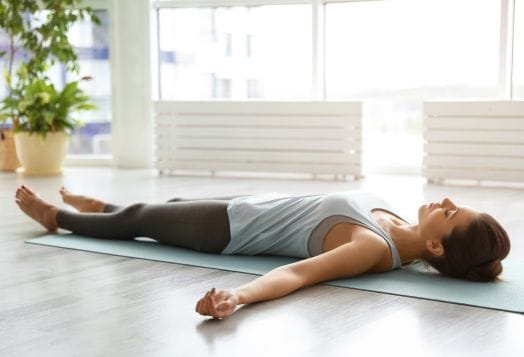Ever heard of a workout that ends with lying down? Probably not—but in yoga, rest is not just allowed, it's encouraged. After all the stretching and sweating, one pose boldly asks you to rest for a few minutes. Yes, it’s the savasana pose– the ‘no movement’ asana that gives you several health benefits. Let’s explore why you should never skip this asana.

What is Savasana and Why it’s More Than Just Lying Down
The term ‘Savasana’ or ‘Savasana’ is derived from the Sanskrit word "shava," meaning corpse, and the suffix "asana," which means pose. Despite its scary name, the practice is anything but grim.
The savasana pose has been a key part of yoga for centuries. Ancient texts like the Hatha Yoga Pradipika (15th century CE) describe it as ‘lying like a corpse’ to achieve deep relaxation and spiritual insight.
The pose also reflects balance in Hindu philosophy—just as activity needs rest, active yoga postures naturally end in the stillness of savasana pose, bringing harmony to body and mind.
Simply put, the answer to ‘What is savasana?’ is the art of active nothingness. Though the posture appears to be as simple as lying down, achieving the full depth of its benefits requires mindfulness and focused awareness.
For those curious about savasana in a broader sense, it is a meditative pause that allows both the nervous system and the muscles to reset.
The Science Behind Savasana
Studies highlight the amazing benefits of savasana beyond just relaxation.
A 2020 study by Jadoun and Yadav found that it helps lower blood pressure, reduces stress, and promotes deep relaxation by calming the nervous system.
In 2016, Bhogal et al. discovered that savasana improves memory, enhances emotional control, and works similarly to meditation in reducing muscle tension.
A 2024 review emphasised its role in reducing stress, supporting heart health, and boosting emotional well-being.
An article from 2023 also linked savasana to better sleep, improved focus, and overall mental clarity—making it a must-have in any wellness routine.
Savasana Benefits for the Body and Mind
The savasana benefits extend far beyond the immediate feeling of relaxation. The practice is known for its ability to restore the body's equilibrium after a demanding yoga session or a long day of mental and physical labour.
Physical Benefits
Muscle Relaxation and Recovery:
During active movement, muscles work hard and often accumulate tension. Savasana provides an opportunity for these muscles to relax fully. The deep relaxation helps release built-up tension, leading to faster recovery.
Enhanced Sleep Quality:
Lying down in a state of mindful awareness helps regulate the sleep cycle. For those who have experienced tossing and turning at night, practising savasana daily might be the key to waking up feeling refreshed.
Mental and Emotional Benefits
Stress Reduction:
By consciously letting go of the day's worries, the mind can enter a state of calm. It is a gentle reminder that sometimes, doing nothing is the best antidote to a chaotic mind.
Improved Focus and Clarity:
A mind that has had a chance to reset in stillness is better equipped to handle the complexities of daily life. Practising savasana can lead to sharper focus, making it easier to deal with the challenges of both work and personal life.
Holistic Well-being
Grounding the Mind-Body Connection:
It supports a deep connection between the mind and body. Many practitioners have discovered that the savasana benefits include emotional stability and a better understanding of one's own inner self.
Inner Peace and Clarity:
Amidst constant noise and distraction, taking time to simply be can help cultivate a lasting sense of inner peace. This state of calm not only helps in daily life but also fosters long-term well-being.
How to Practise Savasana Pose Right

Achieving the full impact of savasana may seem straightforward—simply lie down, relax, and breathe. However, the real benefits lie in the subtleties of this practice. Here are a few simple steps to follow:
Find a quiet space: Choose an environment free from distractions. Whether it is a corner of a living room or a dedicated space in a yoga studio, the surroundings should be calm and soothing.
Assume the savasana pose: Lie flat on the back on a comfortable surface. The body should be fully extended, with legs relaxed and slightly apart. This alignment encourages deep relaxation.
Relax the arms: Place the arms gently by the sides, with palms facing upward. This position is not only comfortable but also symbolises openness and receptivity.
Close the eyes and breathe deeply: Softly close the eyes and bring your attention to the natural rhythm of the breath. Inhale slowly and exhale fully. Focusing on deep, even breaths is key to quieting the mind.
Scan the body for tension: Mentally scan the body for any areas of tension, starting at the toes and moving upwards. Consciously release any tightness, letting each muscle melt into relaxation.
Maintain mindfulness: Keep the mind gently focused on the breath. It is common for thoughts to drift by—consider them as clouds passing in a serene sky. Gently guide the attention back to the breath without judgment.
Consider the use of props: For added comfort, a small cushion or folded blanket can be placed under the knees. This modification in the savasana pose can alleviate lower back tension and enhance overall comfort.
It is a practice that may seem effortless, yet its benefits are unlocked through mindful attention.
YouTube can’t fix your posture. Get guidance from a yoga professional.
Find your instructor now.
Savasana Precautions
Though Savasana is widely regarded as one of the safest yoga practices, it is important to be aware of certain precautions.
Be Mindful of Physical Limitations:
Individuals with chronic back pain or discomfort should consider using props or modifying their posture to prevent strain. The use of a cushion or folded towel under the knees can be a simple yet effective modification.
Avoid Noisy Environments:
Practising savasana in a quiet, distraction-free space is crucial. A loud or disruptive environment can hinder the deep relaxation that is essential for reaping the full savasana benefits.
Do Not Fall Asleep:
While the state of deep relaxation may feel similar to sleep, it is important to remain mindful during the practice. Falling asleep can mean missing out on the mental clarity and body-mind integration that Savasana offers.
Why Skipping Savasana Pose Might Be a Mistake
Skipping the final relaxation might seem like saving time. However, neglecting this asana can be counterproductive. Without it, the body may not fully absorb the benefits of the preceding yoga poses, leaving residual tension that undermines overall progress.
The simple act of lying down with complete awareness can provide the mind with the clarity it needs to process experiences and emotions from the day. The savasana benefits extend into everyday life, promoting a state of calm that carries over even when the yoga mat is left behind.
In essence, skipping savasana is like ending a delicious meal without dessert.
Savasana Pose: The Power Nap You Actually Need
Next time someone tells you that ‘it’s just lying down, so skip it’, smile knowingly. Your five minutes of skilful stillness might be the most powerful move in your entire wellness routine. So roll out your mat (or simply recline wherever you are), take a deep breath, and give yourself the gift of doing absolutely nothing – because sometimes, that's everything. Your body, mind, and spirit will thank you for this small but mighty act of self-care.
Disclaimer: This information provided is intended for general informational purposes only. It is not a substitute for professional advice or guidance. For personalised recommendations or specific concerns, please consult a certified professional.




